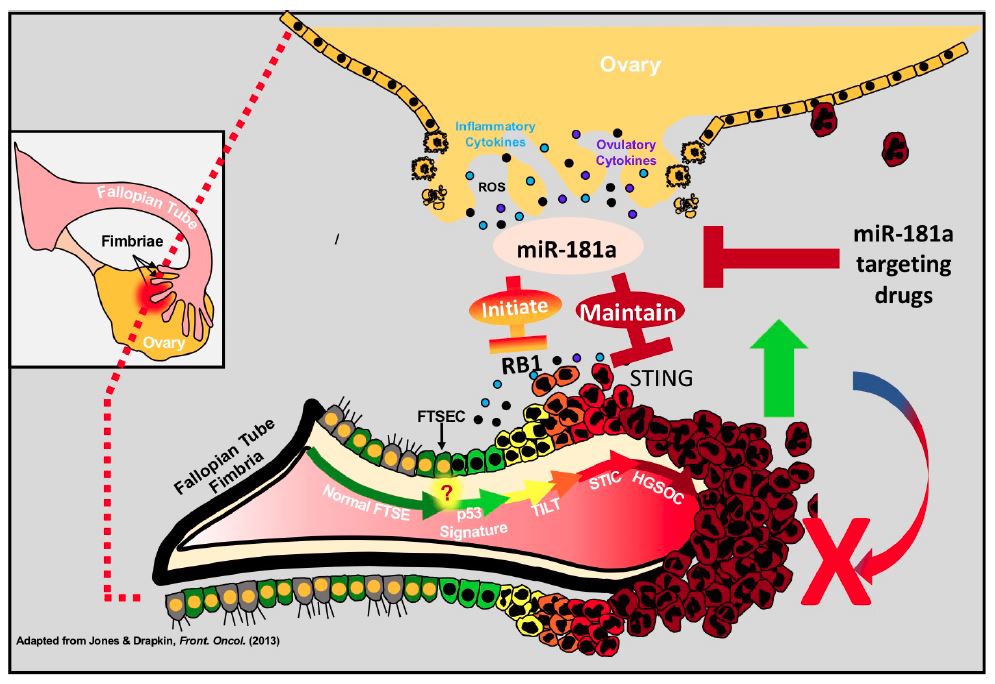Ovarian Cancer
A microRNA Promotes Oncogenic Transformation Leading to Ovarian Cancer



Posted September 1, 2020
Analisa DiFeo, Ph.D., The University of Michigan

Dr. Analisa DiFeo
High-grade serous ovarian cancer (HGSOC) is the most common form of epithelial ovarian cancer and the most lethal because of poor early detection due to a lack of diagnostic biomarkers and the recurrence of chemotherapy-resistant tumors, resulting in poor overall survival. A major challenge to the development of therapies and identification of biomarkers is incomplete understanding of the pathways involved in transformation and disease development. Recognizing the critical need to identify novel therapeutic targets for HGSOC, Dr. Analisa DiFeo dedicated funds from the Ovarian Cancer Research Program (OCRP) to characterize the pathways that mediate malignant transformation of epithelial cells in ovarian cancer in order to identify key drivers to target for treatment.
MicroRNA profiling studies by numerous groups have revealed associations between miRNAs and chemotherapy resistance and disease progression. These studies suggested that microRNA miR-181a in particular was associated with shorter recurrence time in ovarian cancer. With support from a Fiscal Year 2010 (FY10) OCRP Translational Pilot Award, Dr. DiFeo further investigated the role of miR-181a in ovarian cancer. Her team determined that miR-181a is enriched in recurrent ovarian tumors and its expression is associated with shorter time to recurrence and poor patient outcome. Furthermore, they demonstrated that expression of miR-181a leads to ovarian cancer dissemination and progression in mouse models of ovarian cancer.
The OCRP further supported Dr. DiFeo’s research into the role of miR-181a in ovarian cancer development through an FY15 Investigator-Initiated Research Award (IIRA). Dr. DiFeo‘s team demonstrated in ovarian cancer cell lines and mouse models that miR-181a promotes numerous aspects of transformation, most notably genomic instability. Next, the team wanted to look at genes involved in the miR-181a pathways promoting genomic instability, as they could represent therapeutic targets. The team analyzed gene expression changes in fallopian tube epithelial cells in response to miR-181a overexpression and down-regulation. They identified retinoblastoma transcriptional corepressor 1 (RB1), a well-established tumor suppressor in HGSOC oncogenic transformation, as a likely candidate contributing to miR-181a-mediated ovarian cancer development. Dr. DiFeo confirmed direct targeting of miR-181a to RB1 in fallopian tube epithelial cells, indicating that miR-181a down-regulates RB1. The same genomic instability observed in miR-181a overexpression was detected as a result of RB1 inhibition; however, cells with RB1 knock-down alone were not able to survive, and the DNA damage was more extreme compared to the miR-181a overexpressing cells. Thus, RB1 alone was not the only target of miR181-a, and there must be other genes involved allowing the unstable cells to survive.
Dr. DiFeo noticed that the interferon signaling pathway was down-regulated in the gene expression data. Genomic instability is known to activate the interferon pathway via the DNA damage sensing and stimulator of interferon genes (STING); this promotes immune cell infiltration to destroy the damaged cells. Dr. DiFeo’s team confirmed that miR-181a down-regulation of STING leads to a decrease in the interferon pathway. This reduction allows the cells with nuclear defects due to RB1 down-regulation to survive and transform into cancer cells.
With the support of the OCRP FY15 IIRA, Dr. DiFeo and her team revealed the duality by which miR-181a overexpression both advances genomic instability by blocking the tumor-suppressing activity of RB1 and ensures the longevity and propagation of these impaired cells by diminishing the immuno-surveillance of STING signaling. Having proposed this model of action by miR-181a to promote oncogenic transformation of epithelial cells in HGSOC, Dr. DiFeo and her team have presented a novel molecular pathway to target for development of new therapeutic approaches. Furthermore, microRNAs tend to be stable in serum and blood plasma, making them ideal candidates for biomarkers, so determining that miR-181a is involved in the development of ovarian cancer suggests its potential as a biomarker for early detection of ovarian cancer.

This figure illustrates the role miR-181a plays in the transformation of fallopian tube secretory epithelial (FTSE) cells into HGSOC.
Publications:
Parikh A, Lee C, Joseph P, et al. 2014. MicroRNA-181a has a Critical Role in Ovarian Cancer Progression through the Regulation of the Epithelial–Mesenchymal Transition. Nat Commun 5:2977. https://doi.org/10.1038/ncomms3977.
Knarr M, Avelar RA, Sekhar SC, et al. 2020. MiR-181a Initiates and Perpetuates Oncogenic Transformation through the Regulation of Innate Immune Signaling. Nat Commun 11:3231. https://doi.org/10.1038/s41467-020-17030-w.
Links:
Last updated Monday, March 10, 2025














